| There are 2 main types of rimfire bench rest, and these are categorised by the type of rifles used: Target .22 Rimfire Rifle is any rimfire rifle chambered for the .22 Long Rifle cartridge and having a safe manually and mechanically operated firing mechanism, weighing not more than 6.5 KGs inclusive of sight and magazine if applicable. Single loads only are allowed. (A magazine may be used as long as long as the reloading of the cartridge into the breech is by manually pulling back and replacing the bolt ) The barrel must have a minimum length of 457 mm, measured from the face of the bolt to the muzzle. The width of the stock shall not exceed 75 mm at any point and have a flat or convex forearm. The bottom edge of the stock butt, the area that sits and slides in the rear sand bag must be no wider then 30mm. The standard Anschutz, FWB or Walther free or sports rifle will comply. The magnification of telescopic sight shall be unrestricted. Sporter .22 Rimfire Rifle is any rifle chambered for the .22 Long Rifle cartridge and having a safe manually and mechanically operated firing mechanism, weighing not more than 4.0 KGs inclusive of sight and magazine if applicable. Single loads only are allowed. (A magazine may be used as long as long as the reloading of the cartridge into the breech is by manually pulling back and replacing the bolt ). The barrel shall not be less than 457 mm. The width of the stock shall not exceed 57 mm at any point. Barrel and action must be removable from the stock without destruction of stock. Nothing may be fastened to barrel except sights, sight bases and original manufacturers attachments. The magnification of telescopic sight shall be restricted to 12 magnifications (Variable magnification telescopic sights to be set at 12 magnifications or less and taped) Ammunition: Any brand of factory loaded .22 Long Rifle calibre ammunition may be used. It must be commercially available for sale and consist of original, unaltered cartridge case, powder and bullet. Rests: Two-piece rests must be used to shoot from the bench. The front rest can be a sandbag or pedestal type incorporating a sandbag with height and windage adjustments. The rear rest must be sandbag or similar construction. Neither the front nor the rear rest are to grip the rifle or in any way restrict the recoil or twisting action of the rifle when fired. The rifle must be able to easily lift clear of the rests. Neither rest can be fixed to the bench. Blocks, boxes or such to raise sand bags to get proper elevation are permitted. No machine or other rest that can return rifle to battery or which retard recoil is allowed. Definition of Rear Sand Bag: The Rear Sand Bag shall be a bag or combination of bags, without additions or container of dissimilar material from the bag, the cover of which shall be easily flexed by the fingers, and the contents of which shall be a dry, finely divided non-metallic substance such as, but not limited to sand, gravel, or grain, without additives, packed loosely enough so that the bag shall be easily and permanently deformable by pressure of the fingers. The rear sandbag cannot be contained in any manner. A vertical spacer shall be allowed between this bag and the bench. The spacers cannot be fixed in any way to the bag or the bench and shall not incorporate adjustments for windage and elevation. Definition Front Sand Bag: The front rest may be a block or pedestal, and may incorporate adjustments for elevation and windage but shall not have any guiding means which would work with any addition, contour or dimension on the rifle to help return the rifle to the firing position. It shall be used in conjunction with a Sand Bag on which to rest the fore-end of the rifle. The section of fore-end containing the sand bag shall be the full with of the rifle stock and must be such that the rifle can be easily removed in the vertical direction without any front sand bag adjustment. It must also be designed to maintain a 100% contact with the bottom of the fore-end when in its shooting position. The cover and filling of the front bag shall meet the requirements described in the above paragraph, concerning the rear bags. Competition: The match will be 20 shots, 40 shots or 60 shots over 50 metres. There will be one sighting target and an unlimited number of sighters can be fired before the commencement of the business shots, No further sighters can be fired after the commencement of your business shots. Total duration of match will be 20 minutes for a 20 shot match, 30 minutes for a 40 shot match and 40 minutes for a 60 shot match. First Shot: Any first shot on the target that goes anywhere but on the sighter can be called by notifying the Range Officer. He/she will inform the scorer and it will not be scored. Targets: Shall have an overall diameter of 58.4mm, this will be the same specification out to the 7 ring as Smallbore target for 50 metres. See ISSF 6.3.2.2. The 10 ring diameter = 10.4mm, The inner 10 ring diameter = 5mm The 9 ring = 26.4mm The 8 ring = 42.4mm, The 7 ring = 58.4mm. The total diameter of the target will be 58.4mm. The Standard target for 50 metres (ISSF 6.3.2.2) can be used, with all shots outside of the 7 ring scored as zero. Scoring: All bullet holes are scored according to the highest value of the target scoring zone or ring that is touched by the bullet hole, this is determined as in the ISSF rules for scoring the 50M smallbore target. Shots not breaking into a target count as 0 points. If any target has multiple holes, use the lowest scoring hole. Tied Score: In the event of a tie, the count back method starting from the last group of 10 shots will be used to break the tie. If this method does not break the tie, the inner 10 ring will be used. The person breaking the most inner 10 rings will be declared the winner. Note: Ties will not be broken if two or more shooters have perfect scores in the same event. |
| Target Rifle Shooting |
 |
 |
 |
| People may well wonder why a pistol club is offering target rifle shooting in addition to its pistol disciplines. This situation is not really unique. Many overseas countries offer multiple disciplines at their facilities and the Beaudesert Pistol Club services a very large area which has few shooting facilities, therefore it seemed logical to iinclude some of the rifle shooting disciplines in its charter to allow those people in the Shire who would like to shoot rifle events as opposed to pistol events, to do so. The type of rifle shooting discplines being offered are: a. Target Air Rifle Shooting b. Target Smallbore (rimfire) Prone Shooting c. Target 3 Position Smallbore Shooting d. Rimfire Benchrest Shooting The Beaudesert Range is cleared for thesematches and the Club at its Annual General Meeting decided to go ahead with the addition of these disciplines. They are all ISSF disciplines except for the Rimfire Benchrest, which is governed by International Rules. |
| Target Air Rifle It is anticipated that this will prove the most popular of the rifle disciplines engaged in by people at the Club. This is because the match is conducted in fully sheltered facilities with electric target changing facilities, and the ability of people to shoot the match, within the specified time limits, at their own pace. In addition, once the initial equipment purchases are made, the cost of engaging in this particular sport are minimal. The match is open to virtually any single shot, .177 calibre air rifle, and even the most basic of these is capable of producing a respectable score. Those who wish to and who can afford it, can equip themselves with the latest and most elaborate match air rifles and shooting jackets and boots, but none of these things are really necessary unless one wishes to attain very high standards in the sport. The Match is open to men, women and children, 12 years of age and over, and in addition, is particularly suited to people with disabilities, including those with quite extreme disabilities, such as quadraplaegia and various muscle wasting or nervous system related illnesses. The Air Rifle competition is shot at 10m from the standing unsupported position and consists of 60 shots in 1 hr 45 mins for men, possible score - 600, and 40 shots in 1 hr 15 min for women, possible score - 400. For people with disabilities, the shooting position can range from standing unsupported, to seated,and to seated, with the rifle fully supported in a fixture. The Air rifle target is small - very small. The reason for this is twofold. Firstly, the modern match air rifle will put all of the pellets fired from it through the same hole at 10m and secondly, most of the top shooters in the world manage to shoot the possible score or very near to it, regularly. The Air Rifle target looks like this: |
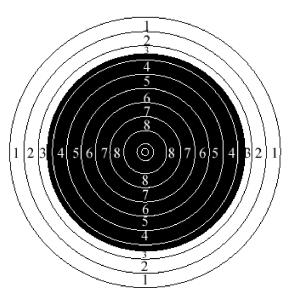 |
| Air Rifle Target Dimensions 10 Ring 0.5 mm (�0.1 mm) 5 Ring 25.5 mm (�0.1 mm) 9 Ring 5.5 mm (�0.1 mm) 4 Ring 30.5 mm (�0.1 mm) 8 Ring 10.5 mm (�0.1 mm) 3 Ring 35.5 mm (�0.1 mm) 7 Ring 15.5 mm (�0.1 mm) 2 Ring 40.5 mm (�0.1 mm) 6 Ring 20.5 mm (�0.1 mm) 1 Ring 45.5 mm (�0.1 mm) No, it isn't a misprint. The ten ring is actually a small dot, .5 mm in diameter. |
| Modern Match Air Rifles |
| Hammerli AR 50 Air Rifle |
| Feinwerkbau LG700 Air Rifle |
| Walther LG300 Air Rifle |
| Diabolo .177 Match Pellet |
| Modern match air rifles are now made with either aluminium or laminated wood stocks. There are two major types - a pneumatic type wherein the rifle is manually cocked with a lever each time, and the compressed air models, which have a tank of compressed air under the barrel. There is virtually no difference iin the accuracy of either type and each has its proponents. |
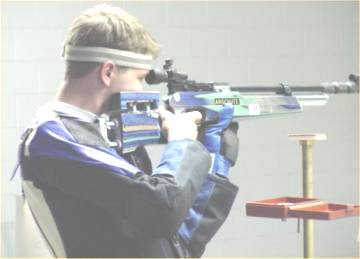 |
 |
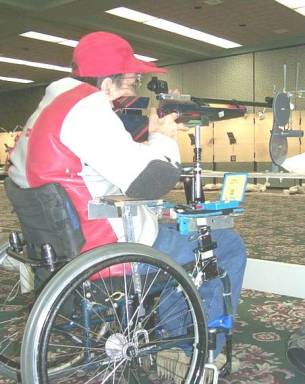 |
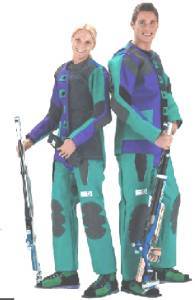 |
| Male Air Rifle Competitor |
| A Very Popular Match for Women |
| A Disabled Shooter who suffers from Cerebal Palsy, competing in a Canadian Match using wheel chair and rifle support |
| Shooting Clothing |
| Both Air Rifle shooters and Smallbore shooters use specialised clothing to help them in their respective matches. The clothing is identical for either discipline. The photo shows competitors wearing jackets, trousers and boots. Soon the ISSF rules will be changed such that the trousers will be banned but jackets and boots will still be permitted. Shooting jackets are now made from a colourful combination of very stiff double layered canvas and leather. Shoulder and elbow pads are covered in a special non-slip rubber compound. The jackets and boots do help the shooter to maintain a steady stance, but are not really essential. |
| Smallbore Rifle Shooting |
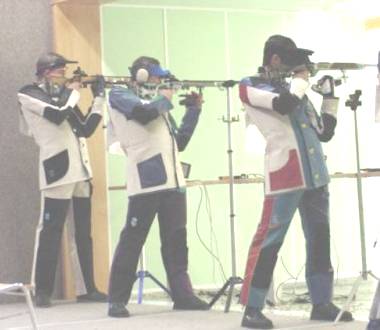 |
 |
 |
| There is nothing dull about modern shooting gear |
| Smallbore rifle shooting means target shooting with the .22 long rifle, rimfire cartridge, using a match rifle. There are two major divisions in this type of shooting and both are practised at the Olympic and Commonwealth Games. One is smallbore Prone and the other is 3 Position. The Prone Match As the name implies, the Prone rifle match involves shooting a 60 shot match for men and women from the lying position at a target 50m away. The time limit is 1 hour 30 minutes but if electronic targets are used, the time is 1 hr 15 mins. The possible score is 600. The target is small as is the 10 ring and this illustrates the accuracy potential of the match rifle/cartridge combination |
| The Prone Rifle Match |
| The 50m Rifle Match Target |
| 10 Ring 10.4 mm (�0.1 mm ) 5 Ring 90.4 mm (�0.5 mm ) 9 Ring 26.4 mm (�0.2 mm ) 4 Ring 106.4 mm (�0.5 mm ) 8 Ring 42.4 mm (�0.2 mm ) 3 Ring 122.4 mm (�0.5 mm ) 7 Ring 58.4 mm (�0.5 mm ) 2 Ring 138.4 mm (�0.5 mm ) 6 Ring 74.4 mm (�0.5 mm ) 1 Ring 154.4 mm (�0.5 mm ) Inner Ten = 5 mm (�0.1 mm). Black from part of 3 to 10 rings = 112.4 mm (�0.5 mm). |
| Target Dimensions |
| There are various factors which affect the accuracy of smallbore rifles including: 1. The quality of the barrel 2. The nature and bedding of the action 3. The stability of the rifle stock 4. The quality and consistency of the ammunition It is the latter factor that has the greatest effect on performance in a competition. Generally speakiing the other factors can be attended to without great difficulty. The provision of match grade ammunition however, relies on the few manufacturers that make this grade of ammunition. The major makers are: 1. Eley (UK) 2. Lapua (Finland) 3. RWS (Germany) 4. Federal (USA) The best of the various grades of ammunition produced by these makers will produce 10 shot groups of around 6mm in diameter at 50 m, which means that this grade of ammunition would be capable of producing possible scores of 600/600, providing the shooter does his/her job. The lesser grades of these ammunition will produce groups 2 to 3 times larger than this which makes top scoring extremely difficult. The maxim in smallbore shooting is to use the best grade of ammunition that can be afforded and that is available. Availability of these ammunitions in Australia is always a problem, particularly with the restrictions placed on the export and import of ammunition world wide, by the various authorities. As a consequence most shooters buy a large quantity of good ammunition when it comes into country. Those shooters lucky (and good) enough to be selected for International representation usually test their rifles with a variety of ammunitions overseas at the various test facilities and try to buy up quantities of ammunition that performs well in their particular rifle. The quality of ammunition available in Australia will always provide a challenge to shooters who wish to attain the highest levels in this sport. Club shooters, however can get away with the lower grades of ammunition and still attain good scores. The 3 Position Match For men, this is a 120 shot match, consistiing of 40 shots Prone, 40 shots Standing and 40 shots Kneeling, at the target shown above at the 50m range. Time limits are: Prone - 1 hr Standing - 1 hr 30 mins Kneeling - 1 hr 15 mins Possible score - 1200 points For women, the match is 60 shots, consisting of 20 shots Prone, 20 shots Standing and 20 shots Kneeling, all to be shot in a total time limit of 2 hr 30 min |
 |
| Prone Segment of Match |
| Standing Segment of Match |
| Kneeling Segment of Match |
| FWB 2602 Match Rifle - Aluminium Stock |
| FWB 2602 Match Rifle - Laminated Wood Stock |
| Anschutz 2013 Match Rifle - Aluminium Stock |
| Anschutz 2013 Match Rifle - Walnut Stock |
| Walther Standard Match Rifle - Wood Stock |
| Match Rifles The 3 position match requires the use of match rifles with elaborate stocks, which include butt hooks and front hand supports. Slings are used for the Prone and Kneeling positions. For the Prone Match a 3 position rifle may be used or a simpler, Prone only rifle can be used. Again, slings are permitted. Sights are aperture front and rear. All of the following rifles are top grade match rifles capable of the highest scores in International competition. |
| In conclusion, if you are a person who ,apart from loving target shooting, is a bit of a gadget lover, then smallbore rifle shooting is the sport for you. There are so many different accessories available for the modern smallbore rifle shooter that it would take a book to cover them all. Pretty much every part of a match rifle can be replaced with a custom item from a variety of makers, all of whom will tell you that with THEIR product, you can reach Olympic gold. There is no way of proving any of these claims. The items offered are generally of top quality but in the end it is a combination of a sound rifle, good ammunition and a dedicated shooter, who will win the medals. |
| Rimfire Bench Rest |
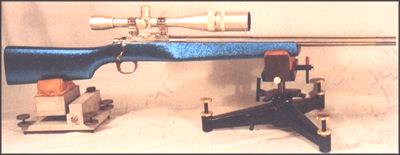 |
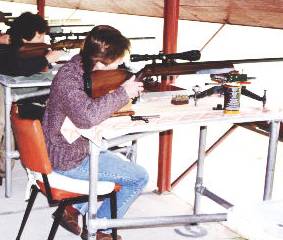 |
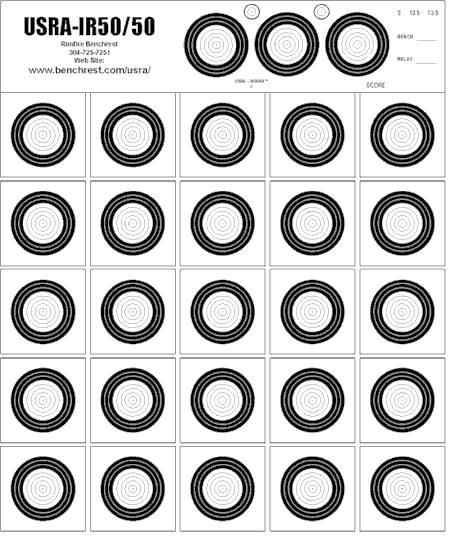 |
 |
 |
| Smallbore Bench Rest Rifle with scope sight and front and rear rests |
| Rifle Front Rest - adjustable for windage and elevation |
| Rifle Rear Bag |
| Bench Rest Shooters in Competition |
| 50 Metre Bench Rest Targets - 1 shot per target |
| This is a very specialised form of rifle shooting and is concerned only with achieving the tightest possible group with one's shots. With rimfire benchrest, however, the aim is not to produce a group as such but to achieve the highest possible score on a very small target. One shot per target is fired and the aim is to achieve a 10 with each shot. Highest score at the end of the competition wins. This type of match is particularly suited to those who are too infirm for the other forms of shooting, or suffer from disabilities that may make the other forms of shooting too difficult. However the sport is also there for those with a scientific bent. Whilst there is no ammunition reloading as in the centrefire benchrest competitions, trying to achieve the best possible grouping with a rimfire rifle can demand that the rifle and its action/barrel combination be perfect and there are many avenues for research in these two areas alone. Ability to judge and allow for the wind is also an important skill to acquire, and although the ammunition used is factory loaded, finding the type which performs best in your rifle can involve a lot of searching and testing. Benchrest shooting can be engaged in as a complete sport or it can be used by target smallbore shooters as a useful adjunct to their normal shooting, in order to produce the best rifle/ammunition combination possible to enhance their ability to achieve high scores in the prone or 3 position matches. Benchrest shooting can be as simple or as complex as one wishes it to be. Anyone with a .22 rilfe and the very simplest of equipment can participate in this type of shooting and win. Ability still plays a mjor part in this type of shooting and it isn't necessarily the most complex or fanciest equipment that is going to ensure a win for a shooter. This type of shooting becomes most addictive after a while and the quest for perfect accuracy can become all-consuming. The dedicated benchrest shooter wouldn't have it any other way. Why not give it a try? |
 |
 |
| Actual size of target |
